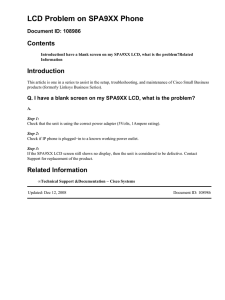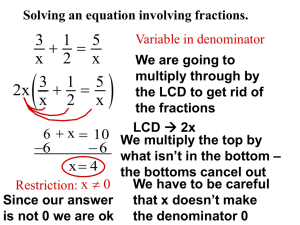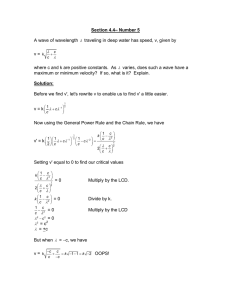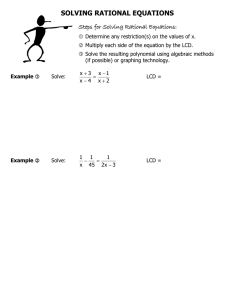HD44780 LCD Starter Guide
advertisement
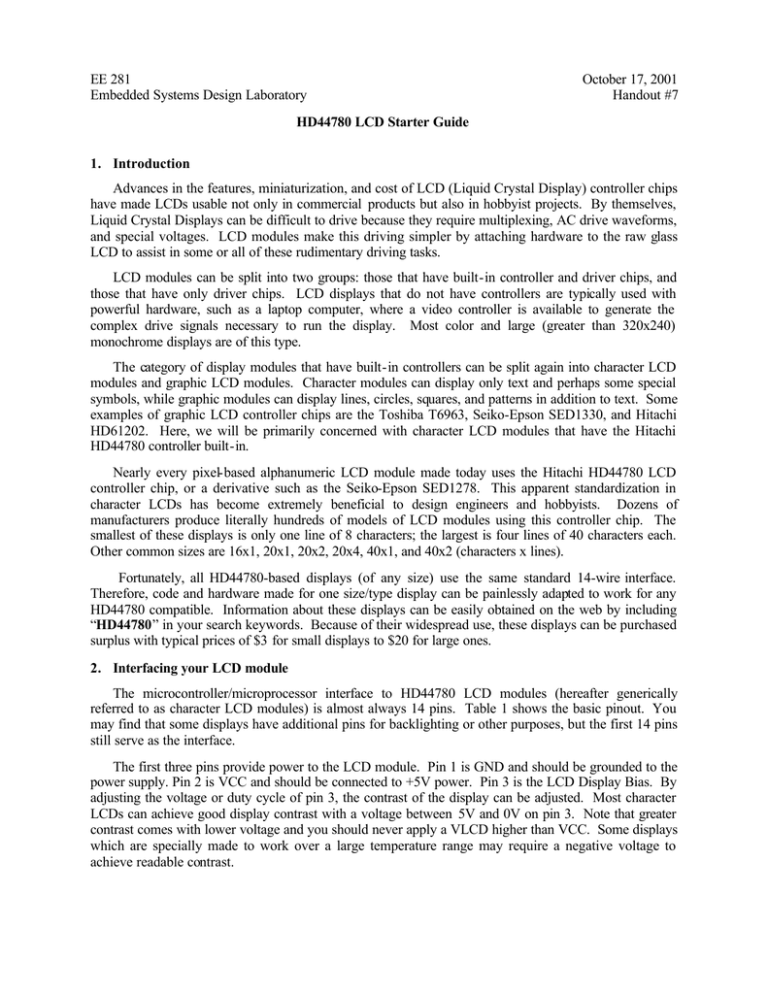
EE 281 Embedded Systems Design Laboratory October 17, 2001 Handout #7 HD44780 LCD Starter Guide 1. Introduction Advances in the features, miniaturization, and cost of LCD (Liquid Crystal Display) controller chips have made LCDs usable not only in commercial products but also in hobbyist projects. By themselves, Liquid Crystal Displays can be difficult to drive because they require multiplexing, AC drive waveforms, and special voltages. LCD modules make this driving simpler by attaching hardware to the raw glass LCD to assist in some or all of these rudimentary driving tasks. LCD modules can be split into two groups: those that have built-in controller and driver chips, and those that have only driver chips. LCD displays that do not have controllers are typically used with powerful hardware, such as a laptop computer, where a video controller is available to generate the complex drive signals necessary to run the display. Most color and large (greater than 320x240) monochrome displays are of this type. The category of display modules that have built-in controllers can be split again into character LCD modules and graphic LCD modules. Character modules can display only text and perhaps some special symbols, while graphic modules can display lines, circles, squares, and patterns in addition to text. Some examples of graphic LCD controller chips are the Toshiba T6963, Seiko-Epson SED1330, and Hitachi HD61202. Here, we will be primarily concerned with character LCD modules that have the Hitachi HD44780 controller built-in. Nearly every pixel-based alphanumeric LCD module made today uses the Hitachi HD44780 LCD controller chip, or a derivative such as the Seiko-Epson SED1278. This apparent standardization in character LCDs has become extremely beneficial to design engineers and hobbyists. Dozens of manufacturers produce literally hundreds of models of LCD modules using this controller chip. The smallest of these displays is only one line of 8 characters; the largest is four lines of 40 characters each. Other common sizes are 16x1, 20x1, 20x2, 20x4, 40x1, and 40x2 (characters x lines). Fortunately, all HD44780-based displays (of any size) use the same standard 14-wire interface. Therefore, code and hardware made for one size/type display can be painlessly adapted to work for any HD44780 compatible. Information about these displays can be easily obtained on the web by including “HD44780” in your search keywords. Because of their widespread use, these displays can be purchased surplus with typical prices of $3 for small displays to $20 for large ones. 2. Interfacing your LCD module The microcontroller/microprocessor interface to HD44780 LCD modules (hereafter generically referred to as character LCD modules) is almost always 14 pins. Table 1 shows the basic pinout. You may find that some displays have additional pins for backlighting or other purposes, but the first 14 pins still serve as the interface. The first three pins provide power to the LCD module. Pin 1 is GND and should be grounded to the power supply. Pin 2 is VCC and should be connected to +5V power. Pin 3 is the LCD Display Bias. By adjusting the voltage or duty cycle of pin 3, the contrast of the display can be adjusted. Most character LCDs can achieve good display contrast with a voltage between 5V and 0V on pin 3. Note that greater contrast comes with lower voltage and you should never apply a VLCD higher than VCC. Some displays which are specially made to work over a large temperature range may require a negative voltage to achieve readable contrast. Table 1: Character LCD Pinout Pin# Name In/Out/Pwr 1 GND Ground Power 2 VCC LCD Controller Power (+3 to +5V) Power 3 VLCD LCD Display Bias (+5 to -5V *see text) Analog 4 RS Register Select: H: Data L: Command Input 5 R/W H: Read L: Write Input 6 E Enable (Data strobe, active high) Input 7 DB0 Data LSB I/O 8 DB1 Data I/O 9 DB2 Data I/O 10 DB3 Data I/O 11 DB4 Data I/O 12 DB5 Data I/O 13 DB6 Data I/O 14 DB7 Data MSB I/O 15 A LED Backlight Anode (optional) Power 16 K LED Backlight Cathode (optional) Power Pins 4,5, and 6 are the control lines for the LCD. These lines indicate what kind of transaction you are proposing to do over the data lines DB0-7. The state of RS indicates whether you wish to transfer commands or display data. The R/W line indicates whether you intend to read or write. Finally, the E line tells the display when you are actually ready to perform the transaction. The control lines RS, R/W, and E, along with the data lines DB0-7 are standard digital logic inputs or outputs. Remember than when performing reads you must set the port connected to DB0-7 to be input. 3. Accessing your LCD module Character LCD modules are accessed through only two “registers”, the Command Register, and the Data Register. When you perform a read or write with RS low, you are accessing the Command Register and giving the module instructions. When you read or write with RS high, you are accessing the Data Register and reading or writing characters/data from or to the display. Table 2 contains pseudo-code examples of reads and writes to the two registers. The pseudo-code can be implemented on any microcontroller and assumes that DBPORT is the port to which DB0-7 are connected. Since some microcontrollers are very fast, delays may be required between the steps described in the pseudo-code. See the concise datasheet on the course web page for more information. Table 2: LCD access pseudo-code Reading from a register Writing to a register 1. set RS line high or low to designate the register you wish to access 1. set RS line high or low to designate the register you wish to access 2. set R/W line high to indicate a read 2. set R/W line low to indicate a write 3. set DBPORT to input 3. set DBPORT to output 4. set E line high to begin read cycle 4. write data to DBPORT 5. pause to allow LCD to fetch the data 5. set E line high to begin write cycle 6. read data from DBPORT 6. pause to allow LCD to accept the data 7. set E line low to finish read cycle 7. set E line low to finish write cycle 4. Initiatizing and programming your LCD Character LCDs must be initialized after power-on and before writing data to the display. The initialization must consist of at least a Function Set command, preferably followed by an Entry Mode Set, Display Control, and a Clear Display. Issuing each of these commands after the Function Set ensures that you know the state of your display. Instructions on how to issue and use these commands can be found by looking at the concise datasheet, or at the HD44780 controller datasheet for more information. Below is an example initialization sequence and “hello world” program assuming you’ve programmed the C functions LcdCommandWrite(unsigned char command) to write commands to the LCD, and LcdDataWrite(unsigned char data) to write data to the LCD: // initiatize lcd LcdCommandWrite(0x38); LcdCommandWrite(0x06); LcdCommandWrite(0x0E); LcdCommandWrite(0x01); // // // // // // // function set: 8-bit interface, 2 display lines, 5x7 font entry mode set: increment automatically, no display shift display control: turn display on, cursor on, no blinking clear display, set cursor position to zero // write “hello world” to the display LcdDataWrite(“H”); LcdDataWrite(“e”); LcdDataWrite(“l”); LcdDataWrite(“l”); LcdDataWrite(“o”); LcdDataWrite(“ ”); LcdDataWrite(“W”); LcdDataWrite(“o”); LcdDataWrite(“r”); LcdDataWrite(“l”); LcdDataWrite(“d”); 5. LCD references on Web sites: http://www.doc.ic.ac.uk/~ih/doc/lcd/ http://home.iae.nl/users/pouweha/lcd/lcd.shtml 6. LCD Character Map

